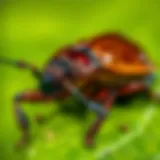DIY Peppermint Spray for Mice: Natural Repellent Guide


Intro
In an era where natural solutions are gaining traction, employing a DIY peppermint spray for mice represents a logical choice for many homeowners. Mice, though small, can cause considerable hassle and damage if they find a way into your home. Utilizing ingredients derived from nature not only aligns with eco-friendly practices but also adds a layer of safety for your family and pets. This article aims to guide readers through the comprehensive steps necessary to formulate and apply peppermint spray effectively.
Understanding how peppermint interacts with the behavior of mice is paramount. Mice have an acute sense of smell, and the strong aroma of peppermint acts as a natural repellent. This overview will set the stage for a deeper examination of pest identification, preventative strategies, and treatment options to keep your home mouse-free.
Pest Identification
Common Pests
When it comes to household pests, mice are notorious for their secretive nature. Typically, there are a couple of species that might invade your space.
- House Mouse: Small in size, usually measuring about 2 to 4 inches long, these mice have a grayish-brown fur covering their bodies. Not particularly picky about their diet, anything from crumbs to pantry food can attract them.
- Field Mouse: Slightly larger than the house mouse, field mice tend to have longer tails and prefer outdoor habitats. They might sneak into your home during cooler months.
Signs and Symptoms of Infestations
Detecting mouse activity in your home can often be done by observing specific signs. Here are some common indicators:
- Droppings: Mice droppings resemble small black grains, usually clustered near food sources or pathways.
- Scratching Noises: Listen for faint noises in the walls, especially at night when it’s quieter. Mice are nocturnal creatures.
- Gnaw Marks: These could be found on furniture, walls, or stored food. Mice need to gnaw to keep their teeth from overgrowing.
- Nests: Shredded paper or fabric tucked away in corners often indicate nesting.
"Early identification is critical in preventing a full-blown infestation. The sooner you act, the better your chances of success."
Recognizing these signs promptly can save a homeowner hassle and promote a swifter response when it comes to containment and treatment.
Prevention Strategies
Home Maintenance Tips for Pest Prevention
The best way to avoid the mess caused by mice is to prevent their entry in the first place. Here are some methods to strengthen your fortress against them:
- Seal Entry Points: Pay close attention to gaps around windows, doors, and vents. Use weatherstripping and caulk to close any openings.
- Proper Food Storage: Keep edibles in airtight containers. Mice love a free meal, so don’t give them the chance!
- Clutter Control: Regularly declutter your home, focusing on attic and basement areas where mice may find cozy spots.
Natural Deterrents and Barriers
Apart from peppermint spray, considering other natural methods can reinforce your defenses:
- Essential Oils: Besides peppermint, consider using oils like eucalyptus or tea tree, both known for their strong aromas that deter rodents.
- Spices: Cayenne pepper and chili flakes sprinkled near entry points can act as deterrents, causing discomfort to the pests.
Treatment Options
Overview of Chemical vs. Natural Treatments
While there are numerous chemical solutions available, opting for natural ones, like peppermint spray, can restore peace without introducing harmful substances into your home. Chemicals often carry risks, especially in households with pets or young children.
Step-by-step Guide for DIY Treatments
Creating your peppermint spray is straightforward and requires limited ingredients:
- Ingredients:
- Instructions:
- Application:
- 2 cups water
- 1 cup peppermint essential oil
- A spray bottle
- Mix the water and essential oil in a bowl.
- Pour the mixture into the spray bottle.
- Shake well before use.
- Spray along baseboards, entry points, and any suspected trails.
The simplicity of this recipe combined with its effectiveness makes it an undeniable choice for those aiming to manage pests naturally.
Equipping yourself with knowledge about identifying pests, employing preventive strategies, and utilizing effective treatment options will arm you with the tools necessary for ongoing pest control. Embracing these practices delivers both peace of mind and a cleaner living environment.
Understanding Mice Behavior and Pest Control
In the arena of pest management, the underlying behavior of mice plays a pivotal role. Understanding how they act not only sheds light on their habits but arms homeowners with the knowledge necessary to thwart their unwanted visits. Mice are crafty creatures, often slipping unnoticed through the tiniest gaps, especially during colder months when they are in search of warmth and food. This can lead to considerable issues if left unchecked.
Grasping the way mice navigate their environment is crucial. Their reliance on scent, sound, and touch leads them to survival, making them adept at finding food sources and shelter. By understanding these behavioral traits, one can develop strategies tailored to deter them effectively.


Moreover, addressing mouse infestations early has its advantages. The longer these rodents remain undetected, the higher the risk of property damage, potential health hazards, and the escalation of breeding. Taking proactive steps can make a world of difference, so let’s break down their behavior into key insights.
The Role of Scent in Mouse Navigation
Mice are highly sensitive to scents, which they use to navigate their environment. Their sense of smell is far superior to that of humans, helping them locate food, detect predators, and even find mates. This olfactory prowess lies at the core of their behavior. Mice leave scent trails using urine and pheromones, which fellow mice can follow. Consequently, any disruption to these trails can throw their navigation off course, creating an opportunity for homeowners to intervene.
Peppermint, with its strong and unmistakable aroma, stands as a powerful deterrent. When applied in areas frequented by mice, its pungent scent can mask familiar odors, leading them to rethink their presence. The idea here is that when they sense something unfamiliar and off-putting, they’ll choose another path, possibly pushing them further away from your home.
Common Symptoms of Mouse Infestation
Identifying early signs of a mouse problem is fundamental. Many individuals might not recognize the subtle indications until the situation becomes untenable. Here are some common symptoms to keep an eye out for:
- Droppings: Tiny, dark pellets typically found around food packages or in hidden corners.
- Nesting materials: Shredded paper, fabric, or insulation tucked into small spaces.
- Noises: Scratching or scurrying sounds, especially at night when they are most active.
- Gnawed items: Signs of teeth marks on food containers, furniture, or wiring.
- Smearing marks: Rub marks left on walls or surfaces where mice frequently travel, causing grease buildup.
By being vigilant and recognizing these symptoms, homeowners can act quickly before a minor nuisance becomes a major infestation. Awareness and early detection serve as the first line of defense in maintaining a pest-free home.
Natural Repellents: An Overview
In the pursuit of pest control solutions, the lure of natural repellents, particularly for mice, is increasingly capturing the attention of homeowners. With a growing awareness surrounding the harmful effects of chemical pesticides, many individuals are shifting toward healthier alternatives that not only safeguard their dwellings but also adhere to an eco-friendly philosophy. Exploring natural repellents allows us to harness the power of nature in tackling pests, thus sparking a resurgence in DIY methods.
Using essential oils, herbal extract, and various natural substances resounds with a comprehensive approach to pest management, attracting those who prefer a gentler touch. It resonates particularly with people eager to maintain safe environments for their families and pets without compromising on effectiveness. Natural repellents often create a multi-faceted defense system against unwanted critters, encouraging an all-around strategy rather than a singular focus on eradication.
*
"Natural pest control is about more than just driving away mice; it’s about fostering a balanced ecosystem within your home."
One of the prominent features of natural repellents is the minimal risk they pose to human health. Traditional pest control methods can inflict detrimental effects on both environment and inhabitants. In contrast, products like peppermint spray manage to create unfavorable conditions for pests without alarming the occupants. For many homeowners, this balance between protection and health is pivotal, which strengthens the argument in favor of such solutions.
Additionally, engaging with the natural world can foster a greater understanding and appreciation for our environment. By emphasizing natural solutions, we become attuned to the benefits nature offers, becoming more mindful of the synergistic relationship between humanity and the ecosystem.
To encapsulate the significance of natural repellents, they present effective tools for pest management while aligning with health-conscious lifestyles and environmental considerations. As we delve deeper into the properties of peppermint, we can glean further insights into why this particular natural solution stands out.
How to Create DIY Peppermint Spray
Creating a DIY peppermint spray is straightforward and immensely beneficial when combatting unwanted mice. The process becomes a delightful mix of science and nature. At its core, this section equips homeowners with the necessary know-how to craft an effective natural repellent. With the growing concerns around chemical pest solutions, understanding how to create your own blend not only contributes to a healthier living environment but also ensures that the method aligns with sustainable practices.
When you master this technique, you're not just arming yourself against a rodent invasion—you’re also engaging in a process that’s environmentally friendly, cost-effective, and remarkably simple.
Gathering Required Ingredients
The effectiveness of your peppermint spray hinges significantly on the quality of its ingredients. The star of your show is, of course, peppermint oil. Its potent aroma has proven to be a deterrent for mice, making it a significant component of your concoction.
Here’s a simple list of what you’ll need:
- Peppermint Oil: This is the primary active ingredient. Opt for high-quality, pure peppermint oil to ensure the strongest scent.
- Water: A carrier for the oil. Distilled water is best as it’s free from impurities.
- Alcohol (optional): Rubbing alcohol can help with the dispersal of peppermint oil in water.
- Spray Bottle: A clean spray bottle (dark-colored, if possible) to store your mixture, which helps maintain the oil's potency.
Collecting these ingredients is the first step to crafting a solution that not only smells refreshing but also works wonders against pesky mice.
Step-by-Step Preparation Process
Once you've gathered your ingredients, it’s time to roll up your sleeves and mix it all together. The preparation process contains several straightforward steps:
- Start with The Water: Begin by pouring about 2 cups of distilled water into the spray bottle. Leaving a bit of space allows for the oil to be added without overflowing.
- Add the Peppermint Oil: Next, incorporate 10–15 drops of peppermint oil into the water. The oil quantity can be adjusted based on how strong you want the scent to be. More drops generally mean a stronger deterrent.
- Incorporate Alcohol (if desired): If you've opted to include rubbing alcohol, add about half a cup to the mixture. This enhances the solubility of the oil in water.
- Shake It Well: Secure the nozzle on the spray bottle and give it a good shake. This helps meld all the ingredients together.
- Label Your Bottle: Consider labeling your spray bottle. Quirky labels like “Mice No More!” can serve as a fun reminder of your natural pest control method.
With these steps, you’ll produce a delightful peppermint spray ready to battle those fur intruders!
Proper Storage Techniques
Once your peppermint spray is prepared, you'll want to store it correctly to maintain its effectiveness. Remember these simple storage tips:
- Cool, Dark Place: Store your spray in a cool, dark area, as exposure to heat and sunlight can diminish the potency of essential oils.
- Keep It Away from Kids and Pets: Ensure that the spray is out of reach from children and pets. While peppermint oil is natural, it’s still wise to be cautious.
- Use Within a Reasonable Timeframe: Although peppermint spray can last for several months if stored properly, it’s best practice to make fresh batches every few weeks to ensure maximum efficacy.
By following these storage techniques, your DIY peppermint spray will be ready for action whenever you need it!
Tip: Always give your bottle a gentle shake before use to remix any settled oils, ensuring a uniform application.
Application of Peppermint Spray


The application of peppermint spray is a crucial step in the endeavor to keep those uninvited mice at bay. Understanding how to effectively apply this natural repellent can enhance its benefits significantly. This section breaks down not just the how-tos, but also the why behind the application process, focusing on maximizing efficacy in a practical manner.
Using peppermint spray can provide a holistic solution that aligns with both environmental consciousness and the practical needs of homeowners. When applied correctly, it serves as a barrier that discourages mice from entering spaces while promoting a fresher atmosphere for inhabitants. Homeowners can expect fewer visits from those sneaky critters, allowing for a more peaceful and healthy living environment.
Identifying Key Areas for Application
When it comes to applying peppermint spray, knowing the prime real estate for targeting is essential. Here are a few focus points that can yield better outcomes:
- Entry Points: Start with places where mice might gain access. Look around entryways, windowsills, and any cracks in walls. A thorough application here can serve as a strong deterrent.
- High Activity Zones: Areas prone to mouse activity, such as kitchens, basements, or garages, warrant extra attention. These are often where you might find crumbs or hiding spots that attract mice.
- Nesting Areas: Attic spaces or behind appliances can double as cozy corners for mice. Spraying peppermint spray in these zones helps in establishing a scent barrier that keeps mice at a distance.
- Garbage and Food Storage Areas: Mice are particularly drawn to food sources. Applying peppermint spray around trash bins or in pantry cabinets can help drive them away from edible goodies.
By targeting these specific areas with peppermint spray, one effectively sets up a multi-layered defensive strategy that maximizes mouse deterrence.
Frequency and Timing of Application
Peppermint spray is not a one-and-done solution. To maintain its effectiveness, regular application is necessary. Here’s how to keep that minty line of defense strong:
- Initial Treatment: Begin by applying the spray every few days to build a strong scent barrier. This initial frequency gives mice less chance to acclimate to their surroundings.
- Maintenance Schedule: After the initial heavy application, switch to a bi-weekly schedule. This reduces the scent intensity without letting it fade entirely. You want to keep them guessing.
- Post-Cleaning Application: Whenever you clean an area—especially kitchens or living spaces—consider reapplying peppermint spray afterward. This helps keep the scent fresh and ensures that any disturbances in the barrier don't invite new guests.
- Seasonal Considerations: Mice tend to search for warmth during colder months. During autumn and winter, increase the application frequency as mice become more active in seeking shelter. Likewise, spring cleaning sessions are a fantastic time for another round of applications.
A consistent approach enhances the peppermint spray’s effectiveness, ensuring that those mice think twice before invading your space.
By adhering to these guidelines for application, homeowners can create an efficient pest management strategy that minimizes the chances of mouse encounters. Consistent application not only protects the home but also upholds a commitment to natural pest control methods that align with sustainable practices.
Effectiveness of Peppermint Spray
The utilization of peppermint spray as a deterrent for mice deserves a thorough examination. Not only does it offer a holistic approach to pest control, but it also aligns with growing ecological concerns. Many people seek alternatives to chemical-laden methods, and peppermint emerges as a frontrunner, blending efficacy with safety. But what makes peppermint spray effective? And how can it be integrated into your pest management routines?
Evaluating Success Rates
To appreciate the effectiveness of peppermint spray, it is vital to assess various success rates reported by users. In numerous anecdotal reports, homeowners have claimed noticeable reductions in mouse activity after employing peppermint spray around vulnerable areas. It seems that, in practice, peppermint deodorizes the space while also creating an inhospitable environment for rodents.
Observational studies simply less formal, show that many individuals notice a marked decrease in sightings of mice after consistently using the spray. Reports mention:
- Diminished sightings: Many claim they haven't seen mice around their property for several days to weeks after initial applications.
- Behavioral changes: Mice appear to become more cautious, leading to a reduction in their typical activities, like rummaging through kitchens or pantries.
Are these claims applicable to every home? Not necessarily. Success often depends on a variety of factors including:
- Severity of the infestation: A minor presence may decline rapidly, while more numerous populations might take longer to deter.
- Environmental conditions: Moist, humid conditions can dilute the effectiveness of peppermint oil, necessitating more frequent applications in such scenarios.
When to Expect Results
Understanding the timeline for visible results from peppermint spray can help manage expectations. Typically, homeowners might start seeing differences within a week or two of regular application. Here’s what to keep in mind:
- Immediate reactions: For mice that cross paths with freshly sprayed areas, immediate distress is often observed. They might retreat quickly, indicating discomfort, though this doesn’t guarantee they won’t return later.
- Cumulative effect: Continuous use reinforces the deterrent effect. It’s a bit like kicking a bad habit; the more consistent you are, the easier it becomes to stay away.
- Timeframe: While results may appear within a week, for complete relief, might take two to four weeks depending on the persistence of the infestation and local conditions. Regular reapplications every few days—especially after cleaning—will help maintain the spray’s effectiveness.
Safety Considerations in Using Essential Oils
Using essential oils, while generally perceived as a natural and effective method for pest control, does come with certain safety considerations that require attention. The concentration and chemical properties of these oils can affect not just mice but humans and pets within the household. It’s essential to navigate these waters carefully to avoid any unintended consequences.
The risks can vary depending on individual sensitivities and health conditions. Therefore, understanding these risks ensures a more informed and safer approach to repelling pests.
Potential Allergies and Reactions
Many people may not realize that essential oils can induce allergic reactions. Peppermint oil, for instance, while known for its effectiveness in repelling mice, can trigger allergies in sensitive individuals. Symptoms can range from skin irritations to respiratory issues. If there’s a history of allergies in the family, it’s prudent to conduct a small patch test prior to widespread use.
- Common signs of an allergic reaction include:
- Itching or burning sensation on the skin
- Rashes or redness
- Difficulty in breathing or wheezing
Furthermore, essential oils contain compounds that, if inhaled in concentrated forms, can lead to respiratory distress. For those with asthma or other pulmonary conditions, a precautionary approach is vital. It’s advisable to ensure proper ventilation when applying the peppermint spray, allowing fresh air to circulate. Keeping windows open or using fans can help diminish concentrated scents.
Precautions for Households with Pets
When it comes to using peppermint spray or any essential oil, households with pets must exercise additional caution. Cats, dogs, and even small animals like hamsters can have adverse reactions to essential oils, which might not be evident immediately.
- Consider the following precautions:


- Keep pets away from treated areas until the spray has dried. This minimizes any risk of ingestion or contact reactions.
- Monitor for any signs of distress in pets after the application. Look for excessive drooling, vomiting, or any unusual behaviors.
- Consult with a veterinarian about the safety of using peppermint oil around pets, as breeds may react differently to these substances.
Adopting a careful and informed approach helps protect both the household and the pets within it. Keeping essential oils safely stored and used thoughtfully ensures a balance between effective pest control and the well-being of all household members.
Complementary Pest Control Strategies
When it comes to keeping mice at bay, relying solely on homemade solutions like peppermint spray can be a bit like trying to catch fish with your bare hands. It might work, but integrating additional strategies amplifies your success in combating these pesky invaders. A multi-faceted approach not only enhances effectiveness but also ensures that you address the root of the problem rather than just the symptoms. Understanding complementary pest control strategies can transform the way you manage your home environment.
Integrating Peppermint Spray into an Overall Plan
Peppermint spray is a fantastic start, but consider it a piece of a wider puzzle. If mice are setting up shop in your home, it often suggests there’s more going on than meets the eye.
- Evaluating Entry Points: First things first, identify places where mice might be sneaking in. Cracks, holes, or gaps around doors and windows are prime suspects. Seal these entry points before dousing your space with peppermint spray.
- Clean Regularly and Reduce Clutter: An inviting home to you may resemble an all-you-can-eat buffet for mice. Keep areas like kitchens and garages tidy. Store food in airtight containers and eliminate crumbs that can attract these unwelcome guests. Also, try to keep clutter to a minimum—mice love that kind of cover during their nighttime adventures.
- Employ Traps as Needed: While peppermint spray works marvelously as a deterrent, some scenarios might call for a more assertive response. It’s wise to keep traps handy, with options varying from humane catch-and-release to traditional snap traps—just ensure you’re familiar with each type’s proper usage and placement.
By embedding peppermint spray within this broader pest management plan, you'll not only repel mice effectively but also create an environment less appealing to them in the first place.
Exploring Other Natural Repellents
While peppermint spray commands attention, it’s wise to look beyond it. Other natural repellents can complement its effects, giving you a kind of anti-mouse trifecta!
- Clove Oil: Another heavy-hitter, clove oil, packs a pungent punch that mice would rather avoid. Just like peppermint, you can mix a few drops with water to create a spray. Apply it in the same spots as your peppermint spray for added protection.
- Vinegar: This old household standby serves more than just salad dressing. Vinegar has a strong scent that can ward off mice when used as a cleaning solution. Mix equal parts vinegar and water to clean surfaces around your home.
- Ultrasonic Repellers: If you’re looking for a tech-savvy option, consider ultrasonic pest repellers. These gadgets emit sound waves that are unpleasant to rodents but elude human ears. Place them strategically around your home for an added layer of defense.
These alternative methods can be integrated seamlessly into your pest control regimen, working in harmony with your peppermint spray to create an inhospitable environment for mice.
A combination of these strategies not only increases the chances of keeping your home rodent-free but fosters a sustainable way of managing pests that respects the natural ecosystem.
By keeping these complementary strategies in mind, you’ll be on your way to crafting a more comprehensive approach to pest control. Not only do they enhance the effectiveness of your peppermint spray, but they also promote a holistic, environmentally-friendly way to keep unwanted critters at bay.
Challenges and Limitations of DIY Peppermint Spray
When it comes to using peppermint spray as a natural deterrent for mice, it is essential to acknowledge the challenges and limitations that may come with this approach. While many households look to DIY solutions, particularly those that align with eco-friendly practices, there exists a reality check that cannot be overlooked. Understanding these obstacles can greatly enhance a homeowner's strategy, ensuring that the use of peppermint spray is both practical and effective.
Understanding Potential Limitations
Creating a peppermint spray might sound like a magical solution to repel mice, but it’s not exactly a one-size-fits-all remedy. One of the primary limitations arises from individual mouse behavioral differences. Not all mice react the same way to peppermint. Some might scurry away at the first whiff, while others may be more persistent. In situations of severe infestation, where mice have established nesting areas, the potency of peppermint may not be strong enough to drive them out completely.
Also, the effectiveness of peppermint spray is often short-lived. Unlike chemical repellents that may leave long-lasting residues, peppermint oil tends to dissipate rather quickly, meaning that regular applications are crucial for maintaining efficacy. This brings to light the need for a consistent application routine; otherwise, the lingering smell that annoys pests will fade, and they might return, leading to a false sense of security.
Furthermore, the environment plays a role too. In humid or enclosed spaces, peppermint oil may lose its bite, so it might require additional consideration in where and how you apply it. It's important, therefore, to not just rely on peppermint spray as the sole measure of pest control, but to also integrate it into a broader pest management strategy.
Common Mistakes to Avoid
When homeowners take on the DIY peppermint spray challenge, there are several common pitfalls to watch out for. First and foremost is poor ingredient quality. Not all peppermint oils are created equally; there can be significant variations in concentration and purity. Cheap oils may dilute the effectiveness considerably. Opting for essential oils with high concentrations, preferably organic, can improve results.
Next, many people underestimate the correct dilution ratios. Unsuitable mixtures may lead to an insufficient spray that does not deliver the necessary repulsive properties on contact. It is recommended to follow a proven recipe or refer to standard guidelines on mixing essential oils.
It’s also crucial to be mindful of the areas of application. Spraying liberally just anywhere will not yield results. Focus on areas where mice frequent, like corners, behind appliances, or entry points. Neglecting these locations can result in wasted efforts. Additionally, don’t forget that peppermint spray should be combined with other preventive measures such as sealing entry points or maintaining cleanliness to truly work effectively.
"Peppermint spray can be a wonderful tool, but it should not be your only tool in the fight against pests."
Overall, recognizing and addressing these challenges will not only enhance the efficiency of using peppermint spray but also contribute to a more comprehensive strategy for effectively managing pest issues in your home.
End
In wrapping up our discussion on using DIY peppermint spray as a natural deterrent for mice, it’s crucial to underscore the significance of this method in pest control. Homeowners are increasingly seeking eco-friendly alternatives to chemical-based pesticides. Peppermint spray stands out not just for its ability to repel unwanted rodents but also for its contribution to a holistic approach toward pest management. The benefits of crafting a solution from readily available ingredients cannot be overstated. It allows individuals to take charge, fostering a sense of empowerment in dealing with household nuisances.
Moreover, as we navigate the complexities of pest problems, employing natural remedies can lead to safer environments for families and pets alike. Peppermint oil offers a dual advantage: its potent aroma drives away mice, while the source of this oil – peppermint – is a common household herb, making it both accessible and familiar.
As you consider your pest control repertoire, this DIY approach isn't just about immediate effects; it's about long-term strategies that foster sustainability. By minimizing reliance on harsh chemicals, homeowners contribute to a healthier planet and promote practices that respect the ecosystem.
Final Thoughts on DIY Peppermint Spray for Mice
Creating a peppermint spray is straightforward and cost-effective. Through the guide provided, homeowners can easily replicate the steps, ensuring they have a reliable repellent at their fingertips. It’s important to recognize that while peppermint spray may not be the panacea for all pest issues, it serves as a valuable component in an integrated pest management plan. Striking a balance between multiple strategies not only enhances effectiveness but also reduces the likelihood of pests developing a resistance to your chosen methods.
The charm of this solution lies in its simplicity and the satisfaction it provides. When you see a mouse scurry away from your neatly applied peppermint spray, it validates your efforts and instills confidence in your pest control endeavors.
Encouraging Sustainable Pest Management Practices
Sustainability in pest control does not merely mean using natural ingredients; it also encompasses a broader perspective. Encouraging practices that respect both the creatures we share our homes with and the environment is vital. Homeowners can foster a culture of prevention rather than reaction, starting with fundamental housekeeping habits.
- Seal any potential entry points to prohibit mice from getting into your home in the first place. This includes checking vents, gaps around doors, and small cracks in walls.
- Maintain cleanliness in kitchens and storage areas, making sure no food sources are accessible.
- Utilize complementary natural deterrents alongside peppermint spray, such as essential oils from eucalyptus or citronella.
By taking a comprehensive view of pest management, individuals not only combat immediate issues but also cultivate a home environment that is resilient against future infestations. Engaging with these sustainable techniques empowers homeowners to become proactive rather than reactive, ultimately leading to a more harmonious coexistence with nature.



